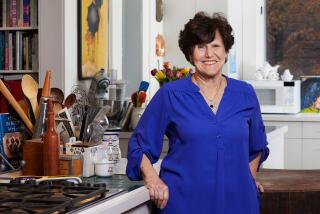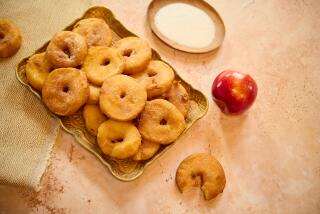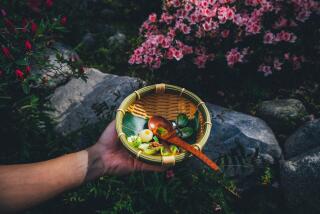Jerusalem Traces 3,000-Year History in Its Food : House of David: Exhibit re-creates six meals ranging from Solomon’s time to German pilgrims of the early 20th Century.
- Share via
JERUSALEM — An exhibit traces 3,000 years of history through the food served in Jerusalem, but omits the most famous meal because no one could agree on what Jesus and his disciples ate at the Last Supper.
“Eating in Jerusalem,” housed in the dungeon of the Tower of David inside the city’s ancient walls, re-creates six meals ranging in time from King Solomon to German pilgrims of the early 20th Century.
“To better understand someone--a writer, a politician--eat with them,” said curator Sherry Ansky. “Do they enjoy their food or do they gobble it up?”
History changed Jerusalem’s menus. The city has been conquered 37 times. Victors introduced dishes and returning soldiers brought foods from other lands.
In a cavernous room of the Museum of the History of Jerusalem, Ansky has a 40-seat rustic wooden table, not unlike those from which Crusader knights once ate.
As visitors examine old menus and look at a three-dimensional display on culinary customs, they are treated to olives and goat cheese spread on sesame-seed bread.
“It’s just to whet their palates, give them a taste,” said Sara Piro, the museum spokeswoman.
Six meals, with foods ranging from smoked meats and pickled eggs to baklava, are shown in photographs accompanied by explanations of ingredients and preparation. The meals were photographed in plates and bowls unearthed in archeological digs at the sites.
They reflect King Solomon’s court, a 2nd-Century Greek-style banquet, a Crusader dinner, a 16th-Century soup kitchen with food donated by the wife of Ottoman ruler Sultan Suleiman, a harem lunch from that era and, from 1910, supper at a German hostel.
Each day, the Bible says, Solomon the Wise (1 Kings, 4:22) used 185 bushels of flour, 375 bushels of meal, 10 fatted oxen and 20 cattle, 100 sheep, deer, gazelles, roebucks and fowl to provide for “all who came to the king’s table.”
Pheasant, a rack of lamb and a cornucopia of vegetables and fruit suffice for the museum display.
Chickens were unknown in Jerusalem until 400 years later, when Jews from Babylon brought them in 537 BC. Rice, a mainstay of the Arab diet, was brought from Persia 200 years after that by Alexander the Great’s retreating soldiers.
In the 12th Century, returning Crusaders added the zest of Oriental spices to Middle East and European food. The harem lunch was a huge meal that ended with Turkish sweets and gossip over strong coffee.
In unusual cooperation with the Israelis, the Higher Islamic Council loaned a 400-year-old iron pot used in a sultan’s soup kitchen to re-create a meal of rice and hulled grains from a recipe in the Arab museum at Al Aqsa mosque.
Ansky said the Last Supper was “too touchy” a meal to include in the exhibit. There is controversy over whether it was a peasant repast of bread, water and porridge or a feast of roast lamb, wine and matzo for the Jewish Passover.
Instead, the museum displays the conflicting accounts of the meal as described in the Bible (Mark 14 and Matthew 26) next to a copy of Leonardo da Vinci’s painting.
“We took the safest route because we didn’t want to offend anyone,” said Piro.
People who visit the exhibit, which runs through November, seem to get caught up in it. Sweets, dried fruits, beans and bread typical of the city are on display, and Ansky said visitors keep snatching them up.
More to Read
Sign up for The Wild
We’ll help you find the best places to hike, bike and run, as well as the perfect silent spots for meditation and yoga.
You may occasionally receive promotional content from the Los Angeles Times.






